2017年南开大学日语语言文学专业考研+参考书+内部资料+出题老师
- 格式:pdf
- 大小:474.33 KB
- 文档页数:7
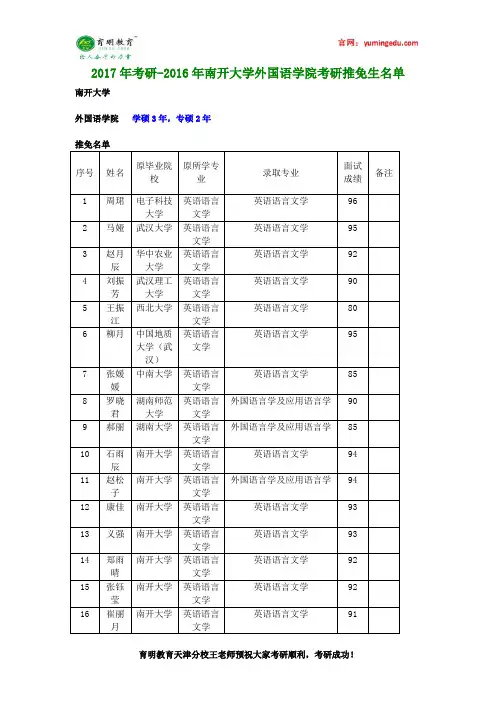

综合类大学1.南开大学在综合大学中,提到日语,就不能不提南开大学。
作为综合性重点大学南开,日语专业的办学水平是全国一流的。
在日本语能力测试的辅导用书中,我们看到最多的都是南开大学出版社的书籍,他们所编纂的辅导用书质量高,重点突出。
”南开大学日本语言文学系拥有教师15人,其中教授3人,副教授10人。
其研究生培养方向主要分为:日本语学方向、日本文学方向、何日本文化方向。
具体来说,日本语学主要涉及日语词汇学、日中语言文化比较研究等领域;日本文学主要研究日本古典文学、日中文学比较等;日本文化方面主要进行日本文化研究、日中文化比较研究等领域的探讨。
南开大学还另设有日本研究院。
本院属于国家重点学科,博士学位授予单位。
是对日本进行综合性研究的实体学术机构。
现有教授7人,且均为博士生导师,副教授10人。
主要研究方向为:日本政治史(博士学位授予权)、日本经济史(博士学位授予权)、日本近代外交史(中日关系史,博士学位授予权)、日本社会史(家族制度史,博士学位授予权)、日本文化史(洋学史)、日本经济(硕士、博士授予权)、日本政治。
招生方向:南开大学日本研究院:世界史日本史方向、国际政治日本政治方向、世界经济日本经济方向;外国语学院:日本语学、日本文学、日本文化专业。
2.吉林大学吉林大学日语研究生招生分为两个机构接收:专业日语和公共日语。
也就是说,专业日语由外国语学院日语系招生;公共日语由公共外语学院招生;但两大专业的毕业生都属于语言及应用语言学的硕士研究生。
吉大日语的毕业生去向广泛,现主要集中在大企业或者ZF外交部门,以及高校科研机构和出版社等岗位。
研究方向:日本语学、日本文学、日本文化。
3.武汉大学武汉大学为近代中国第一批国立大学。
其外国语学院日文系现有教师15人,教授2人,副教授5人。
在武大日文系学习,要求我们同时具备日语语言、文学、历史、政治、经济、外交、社会文化等多方面的基本理论和基础知识。
拥有一定的科学研究能力,但是由于武汉大学学科相对综合,因此报考武大日文系的竞争不是很激烈,适合成绩中上的考生为之努力。
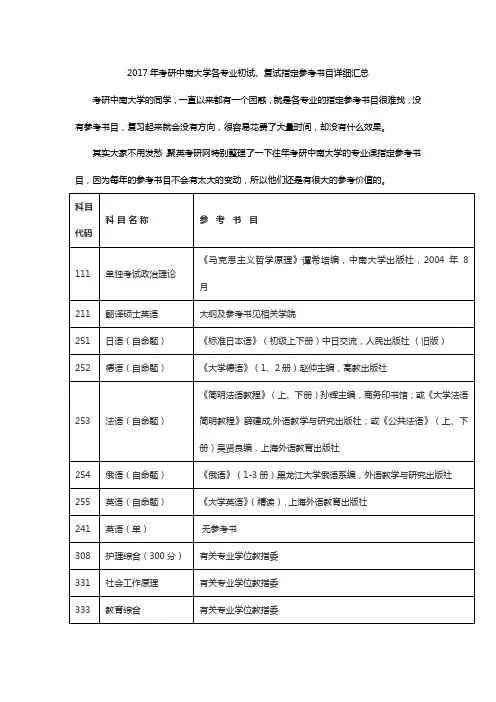

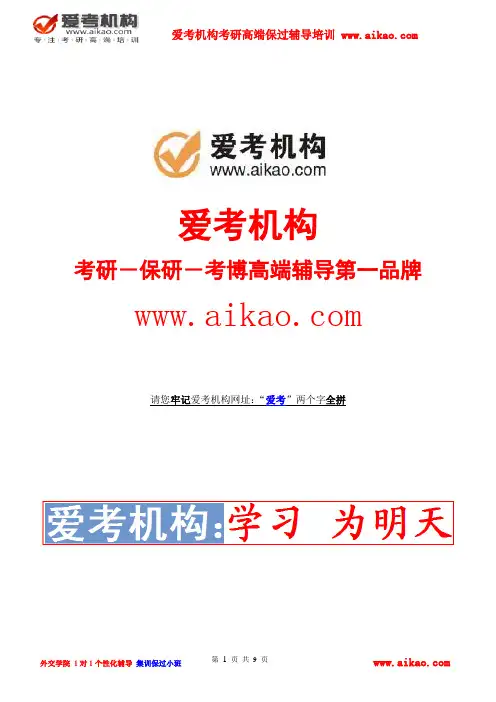
爱考机构考研-保研-考博高端辅导第一品牌请您牢记爱考机构网址:“爱考”两个字全拼外语系 外国语言学及应用语言学(日语)招生目录系所代码及名称 专业代码 及名称 招生人数 研究方向 代码及名称考试科目代码及名称 006外语系050211外国语言学及应用语言学(法语)15 21翻译①101政治 ②248二外英语 ③714法语语言基础④805法汉互译 22外交与国际政治 23中西文化交流 24法语国家研究 050211外国语言学及应用语言学(日语) 12 25日本政治和外交①101政治 ②248二外英语③715基础日语 ④803日本概况 26日本语言文学27日本文化外语系 外国语言学及应用语言学(日语)专业介绍外语系包括法语和日语两个专业。
法语专业设法语教研室,共有教师16人,教研室秘书1人,承担外语系本科法语教学,全院二外法语教学以及法语专业硕士研究生教学。
日语专业设日语教研室,共有教师9人,承担外语系本科日语专业教学,全院二外日语教学以及专业硕士研究生教学任务。
外语系还承担着全院二外德语和二外西班牙语教学任务,负责教学的德语教师和西班牙语教师分别隶属于法语教研室和日语教研室。
系务工作包括党总支、行政、教学管理以及学生管理四方面,共有行政管理人员6人,其中系主任和教学副主任由教师兼任。
法语专业和日语专业分别有本科四个班,即每一年级一个班,每班学生数20人左右,目前全系在校本科学生共150人(法语专业76人,日语专业74人),另外,法语专业在校硕士研究生三个年级,共28人,全日制成人教育法语专业学生34人。
1955年外交学院成立之初,即设法语教研室,负责培养青年学生的本科教学和外交干部法语培训,当时为外交学院三部,同时包括西班牙语教研室。
自1955年建院至1969年学院停办,法语教研室先后培养5届本科学生,1972年,外交部在原外交学院英语教研室和法语教研室的基础上成立外交部干部外语培训学校,1980年外交学院复校,英语和法语两个教研室即转入学院,组成外语系。
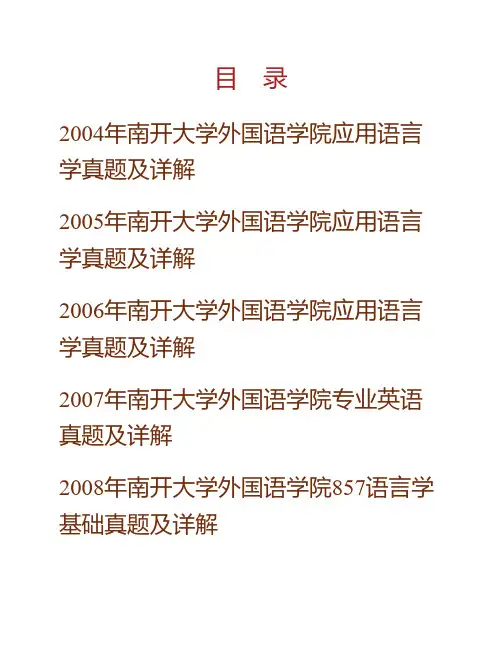
目 录2004年南开大学外国语学院应用语言学真题及详解2005年南开大学外国语学院应用语言学真题及详解2006年南开大学外国语学院应用语言学真题及详解2007年南开大学外国语学院专业英语真题及详解2008年南开大学外国语学院857语言学基础真题及详解2009年南开大学外国语学院857语言学基础真题及详解2010年南开大学外国语学院904语言学基础真题及详解2011年南开大学外国语学院866语言学基础真题及详解2012年南开大学外国语学院883语言学基础真题及详解2004年南开大学外国语学院应用语言学真题及详解考试科目:应用语言学I. Illustrate each of the following terms briefly. (45 points)1. prescriptive linguistics【答案】Prescriptive linguistics: the linguistics that tries to lay down rules for “correct” behaviors. It seeks to tell people how language ought to be used by those who wish to use it.2. Displacement【答案】Displacement: Language can be used to refer to what is present, what is absent, what happens at present, what happened in the past, what will happen in the future or what happens in a far-away place. This property of language enables language users to overcome the barriers caused by time and place. For example, we can talk about Sapir, who is already dead; we can even talk about next week, which is in the future.3.IPA【答案】IPA: the abbreviation of International Phonetic Alphabet, which is devised by the International Phonetic Association in 1888. IPA is a set of symbols which can be used to represent the phones and phonemes of natural languages.4.suprasegmental【答案】Suprasegmental: aspects of speech that involve more than single sound segments. The principle Suprasegmental features are syllable, stress, tone, and intonation.5.blendings【答案】Blending is a process in which two words are blended by joining the initial part of the first word and the final part of the second word, or byjoining the initial parts of the two words. For example, the word “smog” is blended from “smoke” and “fog”.6.denotation【答案】Denotation: the core sense of a word or a phrase that relates it to phenomena in the real world. In the case of linguistic signs, the denotative meaning is what the dictionary attempts to provide. It is the literal meaning of a word, the dictionary meaning, opposite to connotation.7.hyponymy【答案】Hyponymy. It refers to the sense relationship between a more general, more inclusive and a more specific word. The word which is more general in meaning is called the superordinate, and the more specific words are called its hyponyms. For example, the hyponymy relationship could be established between “animal” and “rabbit”.8.stem【答案】A stem is any morpheme or combination of morphemes to which an inflectional affix can be added. For example, “friend-” in friends, and “friendship-” in friendships are both stems. The former shows that a stem can be equivalent to a root, whereas the latter shows that a stem may contain a root and a derivational affix.9.inflectional morpheme【答案】Inflectional morpheme: It is also called inflectional affixes, which attaches to the end of words Inflectional affixes and only add a minute or delicate grammatical meaning to the stem. The plural suffix is a typical example of this kind.10.back-formation【答案】It refers to an abnormal type of word-formation where a shorter word is derived by deleting an imagined affix from a longer form already in the language. For example, from “editor” the word “edit” was generated.11.c-command【答案】C-command: A c-commands B if and only if: 1) A does not dominate B and B does not dominate A; 2) The first branching dominating A also dominates B.12.Sapir-Whorf hypothesis【答案】Sapir-Whorf hypothesis consists of two parts: linguistic determinism and linguistic relativity. Linguistic determinism refers to the notion that a language determines certain nonlinguistic cognitive processes. Different languages offer people different ways of expressing around, they think and speak differently. Linguistic relativity refers to the claim that the cognitive processes that are determined are different for different languages. Thus, speakers of different languages are said to think in different ways. The hypothesis is now interpreted mainly in two different ways: a strong version and a weak one. The strong version believes that the language patterns determine people’s thinking and behavior; the weak one holds that the former influence the later. So far, many researches and experiments conducted provide support to the weak version.13.context of situation【答案】Context of situation: It refers to the linguistic and situational environment in which a word, utterance or text occurs. The meaning of utterances, etc., is determined not only by the literal meaning of the words used but also by the context or situation in which they occur.14.corpus linguistics【答案】Corpus linguistics: an approach to investigating language structure and use through the analysis of large databases to real language examples stored on computer. Issues amenable to corpus linguistics include the meanings of words across registers, the distribution and function of grammatical forms and categories, the investigation of lexico-grammatical associations, and issues in language acquisition and development. 15.CALL【答案】CALL: It is the abbreviation of computer-assisted language learning, which refers to the use of a computer in the teaching or learning of a second or foreign language. In this kind of CALL programs, the computer leads the student through a learning task step-by-step, asking questions to check comprehension. Depending on the student’s response, the computer gives the student further practice or progresses to new material.II. Name each of the following IPA symbols. (10 points)1.[]【答案】voiceless postalveolar fricative2.[j]【答案】palatal approximant3.【答案】glottal plosive4.[w]【答案】bilabial approximant5.[x]【答案】voiceless velar fricative6.[υ]【答案】high back lax rounded vowel7.[æ]【答案】low front lax unrounded vowel8.[p]【答案】voiceless bilabial plosive9.【答案】voiceless aspirated affricate10.[d]【答案】voiced post-alveolar affricateIII. Read each of the following statements carefully and decide whether it is true or false. (10 points)1.Odgen and Richards argue that the relation between a word and a thing it refers to is not direct.【答案】T【解析】本题考查语义三角理论。
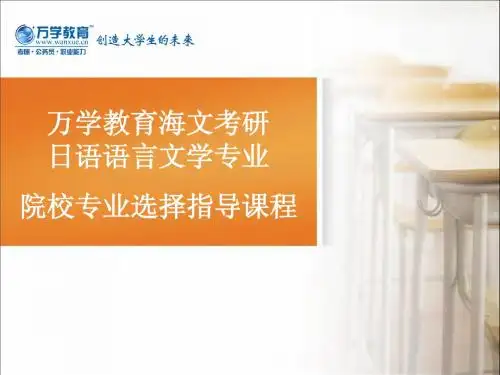
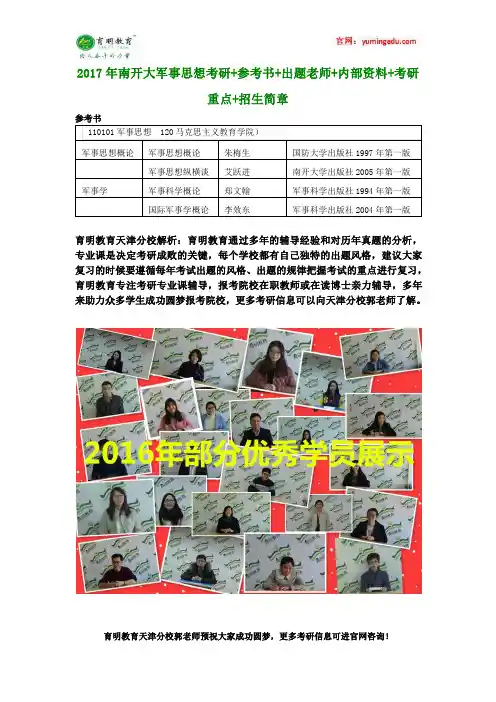
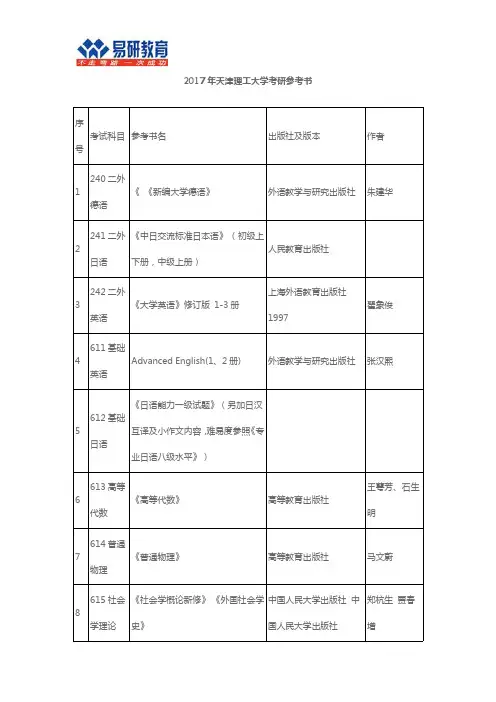
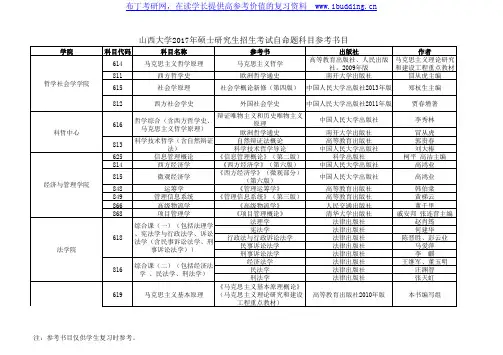
山西大学2017年硕士研究生招生考试自命题科目参考书目
山西大学2017年硕士研究生招生考试自命题科目参考书目
山西大学2017年硕士研究生招生考试自命题科目参考书目
山西大学2017年硕士研究生招生考试自命题科目参考书目
山西大学2017年硕士研究生招生考试自命题科目参考书目
山西大学2017年硕士研究生招生考试自命题科目参考书目
历史文化学院
山西大学2017年硕士研究生招生考试自命题科目参考书目
山西大学2017年硕士研究生招生考试自命题科目参考书目
山西大学2017年硕士研究生招生考试自命题科目参考书目
山西大学2017年硕士研究生招生考试自命题科目参考书目。

2021年北京师范大学日语语言文学考研招录数据、参考书、考研经验等指导分析一、招生情况(参考20年)专业及方向:050205日语语言文学01日本文化02日本文学03日语语言与教学学习方式:全日制初试科目:①101思想政治理论②201英语一或244二外法语③711基础日语④811日语语言文学复试科目:日语专业基础招生计划:20年本专业拟招收7人,含接收推免生5人左右.20年本专业复试内容:1.考生须按照面试专家的要求,汇报本科阶段的课程学习、毕业论文、科研情况等;2.考查知识结构;3.考查日语口语;4.考查日本语言和社会文化理论及科研实践。
5.复试满分300分,复试总分低于180分为复试不合格。
6.总成绩=初试总分+复试总分。
7.按专业根据考生总成绩从高到低依次录取。
总成绩相同时,按初试总分从高到低依次录取。
复试不合格考生不予录取。
二、20考研日语语言文学专业课考试大纲711基础日语考查范围:日语语言基础知识及应用具体内容与分值分布文字、词汇(20分):汉字注假名,根据假名读音写出汉字。
古文基础(5分):古文常识、古文词语、文法、古汉文等方面的基本知识。
语法与表达(55分):日语语言基础知识运用,包含词汇、惯用句、语法知识、日语写作等。
读解(50分):文章内容涵盖语言、文学、历史、社会、文化、经济等各方面。
文章体裁包括散文、议论文、说明文、小说等多种。
要求考生不仅能够准确把握主旨,而且能够准确理解细节。
试题难度不低于日语专业本科毕业优秀水平。
翻译(20分):考查考生是否能在正确理解原文(汉语或日语)的基础之上,将之转换为相应的译文(日语或汉语)。
除关注语言的准确性之外,还考查学生的读者意识。
811日语语言文学一、考试内容日语语言文学的考察范围包括:日语语言学、日本文学史和日本概况的基本知识和基本理论。
重点考察考生对基础知识和基本理论的了解、掌握情况和理解、分析和提出解决问题方案的能力。
具体内容如下。
爱考机构考研-保研-考博高端辅导第一品牌请您牢记爱考机构网址:“爱考”两个字全拼国际关系学院 日语语言文学招生目录我校2013年计划招收政治经济学、世界经济、中外政治制度、国际政治、国际关系、英语语言文学、法语语言文学、日语语言文学、通信与信息系统、应用化学等专业学术型硕士生及英语笔译、英语口译、日语笔译、日语口译、电子与通信工程等专业学位硕士生共计220名,其中,国家计划内硕士生(含定向培养)约占65%,国家计划外硕士生(含自筹经费和委托培养)约占35%。
专业、代码、研究方向招生 人数考试科目备注050205日语语言文学5① 101思想政治理论② 251二外英语或252二外俄语或254二外法语或255二外德语③ 714日语语言文学专业基础 ④ 861日语语言文学专业综合学制二年国际关系学院 日语语言文学专业介绍8、日语语言文学专业(学术型硕士、专业代码:050205)本专业培养坚持四项基本原则、热爱祖国、具有高尚道德情操、素质全面、德才兼备的日语专门人才。
要求学生对日本文化和文学具有广泛的了解,并熟悉日本的社会、政治、经济等方面知识,毕业后能以日语为主要工具从事教学、科研、翻译、文化或外事领域中较高层次的工作。
学制二年,授予文学硕士学位。
本专业培养具有较强的政治素质和国际视野、扎实的日语专业知识和英语水平,熟练的日语应用能力和较强的综合分析能力,熟悉日本基本情况,胜任国家机关、涉外企事业单位、教学科研机构等各种涉外事务管理、研究等工作的日语专门人才。
本专业重视课堂教学与实践相结合,重视学生语言运用能力的培养,积极创造外语学习环境,有完备的语言教学设备和充实的外文影视资料,长期聘有外国专家授课。
主要开设基础日语(精读、泛读、听说、写作)、口译、笔译、日本传媒跟踪、高级日语视听说、日文报刊选读、日本概况、日本政治经济概论、国际关系史等课程,并必修英语。
本专业目前开设应用日语方向,基本学制四年,授予文学学士学位。
710法学综合①《宪法》(第三版),周叶中主编,高等教育出版社、北京大学出版社,2011年版;②《民法》(第四版),魏振瀛主编,北京大学出版社、高等教育出版社,2010年版;③《民事诉讼法学》,江伟主编、傅郁林副主编,北京大学出版社,2012年版;④《刑法》(第五版),高铭暄、马克昌主编,北京大学出版社、高等教育出版社,2011年版。
801国际法专业①《国际法》(第四版),邵津主编,北京大学出版社、高等教育出版社,2011年版;②《国际私法》(第三版),李双元主编,北京大学出版社,2012年版;③《国际经济法》(第三版),余劲松、吴志攀主编,北京大学出版社、高等教育出版社,2009年版。
711政治学综合一①《国际关系理论:思想、范式与命题》,王帆、曲博主编,世界知识出版社,2013年版;②《权力·制度·文化》,秦亚青著,北京大学出版社,2005年版;③《政治学基础》,王浦劬等,北京大学出版社,2006年版。
712政治学综合二①《政治科学基础》,唐晓、杨帆著,世界知识出版社,2007年版;②《政治学十五讲》,燕继荣著,北京大学出版社,2013年版。
802国际关系史①《简明国际关系史(1945—2002)》,肖月、朱立群主编,世界知识出版社,2003年版。
②《国际关系史》,刘德斌主编,高等教育出版社,2003年版;③《近现代国际关系史》,唐贤兴主编,复旦大学出版社,2002年版。
806外交学①《外交学概论》,鲁毅等编,世界知识出版社,2004年版;②《中国近现代外交史(第二版)》,熊志勇等著,北京大学出版社,2014年版;③《中国当代外交史:1949—2001》,谢益显主编,中国青年出版社,2002年版;④《外交决策》,张历历著,世界知识出版社,2007年版。
807经济学综合①《现代世界经济论纲》,江瑞平、竺彩华主编,经济科学出版社,2012年版;②《西方经济学(微观部分)》,高鸿业主编,中国人民大学出版社,第五版;③《西方经济学(宏观部分)》,高鸿业主编,中国人民大学出版社,第五版。